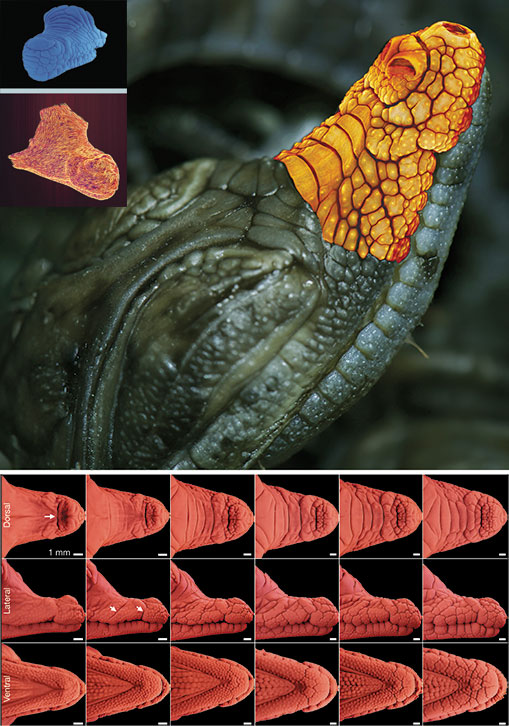Self-Organized Scales
By Fenella Saunders
The skin on crocodilian faces forms into scaly patterns through mechanics, not genetics.
The skin on crocodilian faces forms into scaly patterns through mechanics, not genetics.

A baby Nile crocodile hatches out of its egg, its small body covered with patterned scales. But the scales on its face are irregular, long on top of its snout but smaller and more clustered on the sides of its jaw (below, top image). And the scales aren’t the same on the left and right sides of its head, either. Indeed, the pattern is unique to each individual. “They don’t have fingerprints, but they have face prints,” jokes biophysicist Michel Milinkovitch of the University of Geneva.
Milinkovitch studies patterning in biological organisms, and he and his team had figured out that this face scale growth is solely a mechanical process, not governed by genetic factors. The scales there are not individual units, but are formed as the skin grows by area borders propagating and connecting. But what growth processes govern this patterning? Milinkovitch and his team wanted to know if the skin is being compressed into folds, or if it is being pulled apart into indentations that are more like cracks that form in a drying mud patch—but in this case brought on by the rapid jaw growth of baby crocodiles.
The researchers developed a 3D laser-imaging technique so they could view the developing scales of the embryonic crocodiles (below, bottom image). Their data showed the increasing complexity of the skin folds over gestation time, but also revealed that the skin continually gets stiffer during the process. The skin also was growing faster than the underlayer of stiffer tissues to which it was attached.

Santos-Durán, Cooper, Timin, Jahanbakhsh, and Milinkovitch/University of Geneva
By injecting the embryos with a protein that promotes growth of only the epidermis, the top layer of the skin, the team was able to see that the process was caused by compression, not tension. If the skin was in tension, faster growth would make it smoother. Instead, the team saw that the protein-treated crocodiles had more skin growth, which formed convoluted, labyrinthine patterns made of smaller, denser scales, as the fast-growing epidermis was constrained by the slower-growing underlayer of skin, or dermis, it was attached to, and therefore buckled and folded.
Milinkovitch explains that similar mechanical processes govern the formation of folds in the brain, protrusions called villi in the intestine, and the surface patterning on the noses of dogs and cows.
To understand the skin structure further, the team developed a dye technique to image the collagen fibers that underlie it (above, bottom inset image). These fibers play a major role in how the skin forms, and they resist tension, said Milinkovitch. They found that in crocodiles, the collagen fibers are aligned perpendicularly across the top of the jaw—in keeping with the elongated scale pattern found there—whereas the fibers form a more random, crosshatched arrangement along the sides, where the scales cluster together more closely.
All of the imaging data and measurements of the crocodile’s skull, collagen, dermis, and epidermis then went into a computer model of crocodile growth, which was able to accurately simulate the crocodile face scale pattern (above, top inset image). The team could then alter parameters in the model—such as the rate of dermis growth or the placement of collagen—to demonstrate how each element affected the resulting scale pattern. “You can test many things you cannot do in vivo,” says Milinkovitch. For example, the team noticed that their protein-treated embryos, once they hatched, had a pattern of face scales that resembled those of a caiman. Their model showed that changing only the growth and stiffness parameters could explain the different scale patterns seen on the faces of other crocodilians, such as spectacled caimans or American alligators, again indicating that these were all mechanical and not genetic growth processes.
As a bonus, the model also accurately simulated the bumps on the inside of the crocodile’s mouth, which the researchers hadn’t explicitly programmed into it. “So for free we got the patterning of the palate,” says Milinkovitch. “It emerged from the same process, which was super cool, because it was an independent test of the validity of our model.”
Milinkovitch emphasizes that mechanical patterning can be an underappreciated mechanism in biological development. “In multicellular organisms, you start from a very simple cell, and then you develop into something super complicated, and we still don’t completely understand how this patterning process works,” he says. “There are tons of processes that are at the interface between biology and physics, so it cannot be all genetics, and there is no way we can pretend to understand development if we ignore mechanics.”
Click "American Scientist" to access home page
American Scientist Comments and Discussion
To discuss our articles or comment on them, please share them and tag American Scientist on social media platforms. Here are links to our profiles on Twitter, Facebook, and LinkedIn.
If we re-share your post, we will moderate comments/discussion following our comments policy.